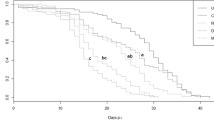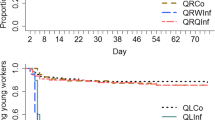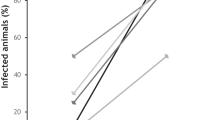Summary
Parasites of social insect workers can be transmitted within the colony to other, related host individuals or, alternatively, to unrelated workers of other colonies. Division of labour affects the probability of transmission, as young individuals often work inside the nest whereas older ones often leave the nest to forage. Therefore, the relative probabilities of transmission within-vs. between-nests is also affected by the delay between host infection and the shedding of propagules, i.e. the latent period of the parasite strain. We therefore hypothesized that strains of the flagellate parasite Crithidia bombi (Trypanosomatidae, Zoomastigophorea) infecting workers of the bumble bee Bombus terrestris (Hymenoptera, Apidae) could differ in their delays and coexist in a population. This would be the case if strains that are shed after a short time delay were more efficiently transmitted to other colony members, whereas strains with long delays were more efficiently transmitted to non-related workers in the population. We tested this hypothesis by experimentally varying time delay and by allowing transmission to either sister workers from the same nest or unrelated workers from other nests. Transmission of C. bombi was measured as the number of parasitic cells shed by the exposed workers after a standard period. The results showed that relatedness as such had no effect, but that delay and nest identity were highly significant effects to explain variation in transmission success. There was a significant interaction between nest identity and delay, such that bees of some colonies acted as efficient transmitters for C. bombi under short delays and vice versa. We discuss how division of labour may affect parasitism in social insects and, vice versa, how division of labour may be under selection from the effects of parasitism, using available evidence from the literature.
Similar content being viewed by others
References
Alford DV (1975) Bumblebees. Davis-Poynter, London
Anderson RM, May RM (1982) Coevolution of hosts and parasites. Parasitology 85:411–426
Bailey L, Ball BV (1991) Honey bee pathology. Academic, London
Bailey L, Gibbs AJ (1964) Acute infection of bees with paralysis virus. J Insect Pathol 6:395–407
Bailey L, Ball BV, Perry JN (1983) Honeybee paralysis: its natural spread and its diminished incidence in England and Wales. J Apic Res 22:191–195
Bitner RA, Wilson WT, Hitchcock JD (1972) Passage of Bacillus larvae spores from adult honeybees to attendant workers (Apis mellifera). Ann Entomol Soc Am 65:899–901
Brian AD (1952) Division of labour and foraging in Bombus agrorum Fabricius. J Anim Ecol 2:223–240
Buschinger A (1973) Ameisen des Tribus Leptothoracini (Hymenoptera: Formicidae) als Zwischenwirte von Cestoden. Zool Anz 191:369–380
Calderone NW, Page REJ (1991) Evolutionary genetics of division of labor in colonies of the honey bee (Apis mellifera). Am Nat 138:69–92
Cameron SA (1989) Temporal patterns of division of labor among workers in the primitively eusocial bumblebee Bombus griseocollis (Hymenoptera, Apidae). Ethology 80:137–151
Clark TB (1977) Spiroplasma as a new pathogen in the honeybees. J Invert Pathol 29:112–113
Craig R, Crozier RH (1979) Relatedness in the polygynous ant Myrmecia pilulosa. Evolution 33:335–341
Doull KM, Cellier KM (1961) A survey of the incidence of Nosema disease (Nosema apis Zander) in honey bees in South Australia. J Insect Pathol 3:280–288
Ewald PW (1987) Transmission modes and the evolution of the parasitism-mutualism continuum. Ann NY Acad Sci 503:175–206
Ewald PW (1993) The evolution of virulence. Sci Am 268:56–62
Feener DHJ (1987) Size-selective oviposition in Pseudaceton crawfordi (Diptera: Phoridae), a parasite of fire ants. Ann Entomol Soc Am 80:148–151
Feener DHJ (1988) Effects of parasites on foraging and defense behavior of termitophagous ants, Pheidole titanis Wheeler (Hymenoptera: Formicidae). Behav Ecol Sociobiol 22:421–427
Free JB (1955) The division of labor within bumblebee colonies. Insectes Soc 2:195–212
Free JB (1958) The drifting of honey bees. J Agric Sci 51:294–306
Free JB (1965) The allocation of duties among worker honeybees. Symp Zool Soc London 14:39–45
Fyg W(1964) Anomalies and diseases of the queen honey bee Annu Rev Entomol 9:207–224
Garofalo CA (1978) Bionomics of Bombus (Fervidobombus) morio. 2. Body size, length of life of workers. J Apic Res 17:130–136
Gary NE, Page REJ, Lorenzen K (1989) Effect of age of worker honey bees (Apis mellifera) on tracheal mite (Acarapis woodi) infestation. Exp Appl Acarol 7:153–160
Goldblatt JW, Fell RD (1987) Adult longevity of workers of the bumblebees B. fervidus, B. pennsylvanicus. Can J Zool 65:2349–2353
Gordon DM (1983) Daily rhythms in social activities of the harvester ant, Pogonomyrmex badius. Psyche 90:413–424
Gordon DM (1991) Behavioral flexibility and the foraging ecology of seed-eating ants. Am Nat 138:379–411
Herbers JN (1983) Social organization in Leptothorax ants: within and between species patterns. Psyche 90:361–386
Hohorst W, Graefe G (1961) Ameisen — obligate Zwischenwirte des Lanzettegels (Dicrocoelium dendriticum). Naturwissenschaften 48:229–230
Hblldobler B, Wilson EO (1990) The ants. Springer, Berlin
Jeanne RL (1986) The evolution of the organization of work in social insects. Monit Zool Ital (NS) 20:119–133
Jouvenaz DP (1983) Natural enemies of fire ants. Fla Entomol 66:111–121
Jouvenaz DP, Lofgren CS, Allen GE (1981) Transmission and infectivity of spores of Burenella dimorpha (Microsporidae, Burenellidae). J Invert Pathol 37:265–268
Keymer AE, Read AF (1991) Behavioural ecology: the impact of parasitism. In: Toft CA, Aeschlimann A, Bolis L (eds) Parasitehost associations: coexistence or conflict? Oxford University Press, Oxford, pp 37–61
Kramm KR, West DF, Rockenbach PG (1982) Termite pathogens: transfer of the entomophagous Metarhizium anisoplia between Reticulitermes sp. termites. J Invert Pathol 40:1–6
Ladle RJ (1992) Parasites and sex: catching the red queen. Trends Ecol Evol 7:405–408
Lipa JJ, Triggiani O (1980) Crithidia bombi sp.n. a flagellated parasite of a bumble-bee Bombus terrestris L. (Hymenoptera, Apidae). Acta Protozool 27:287–290
Lively CM (1987) Evidence from a New Zealand snail for the maintenance of sex by parasitism. Nature 328:519–521
Lively CM (1989) Adaptation by a parasitic trematode to local populations of its snail host. Evolution 43:1663–1671
Loos-Frank B, Zimmermann G (1976) Ueber eine dem Dicrocoelium-Befall analoge Verhaltensdnderung bei Ameisen der Gattung Formica durch einen Pilz der Gattung Entomophthora. Z Parasitenkde 49:281–289
Michener CD (1974) The social behavior of the bees. Harvard University Press, Cambridge
Moore J (1983) Responses of an avian predator and its isopod prey to an acanthocephalan parasite. Ecology 64:1000–1015
Moore J (1984) Altered behavioral responses to intermediate hosts — an acantocephalan parasite strategy. Am Nat 123:572–577
Müller CB, Schmid-Hempel P (1993) Correlates of reproductive success among field colonies of Bombus lucorum L.: the importance of growth and parasites. Ecol Entomol 17:343–353
Oster GF, Wilson EO (1978) Caste and ecology in the social insects Princeton University Press, Princeton
Pamilo P (1981) Genetic organization of Formica sanguinea populations. Behav Ecol Sociobiol 9:45–50
Pamilo P, Varvio-Aho S-L (1979) Genetic structure of nests in the ant Formica sanguinea. Behav Ecol Sociobiol 6:91–98
Pearson B (1983) Intra-colonial relatedness amongst workers in a population of nests of the polygynous ant Myrmica rubra Latreille. Behav Ecol Sociobiol 12:1–14
Robinson GE, Page ERJ (1989a) Genetic basis for division of labor in an insect society. In: Breed MD, Page REJ (eds) The genetics of social evolution. Westview, Boulder, pp 61–80
Robinson GE, Page REJ (1989b) Genetic determination of nectar foraging, pollen foraging, and nest-site scouting in honey bee colonies. Behav Ecol Sociobiol 24:317–323
Rodd FH, Plowright RC, Owen RE (1980) Mortality rates of adult bumble bee workers (Hymenoptera, Apidae). Can J Zool 58:1718–1721
Royce LA, Rossignol PA, Burgett DM, Stringer BA (1991) Reduction of tracheal mite parasitism of honey bees by swarming. Phil Trans R Soc London, B 331:123–129
Salzemann A, Plateaux L (1987) Reduced egg laying by workers of the ant Leptothorax nylanderi in presence of workers parasitized by a cestoda. In: Eder J, Rembold H (eds) Chemistry and biology of social insects. Peperny, Miinchen, p 45
SAS Institute (1990) SAS user's guide: statistics, Version 6. SAS Institute, Cary
Schmid-Hempel P, Müller C, Schmid-Hempel R, Shykoff JA (1990) Frequency and ecological correlates of parasitism by conopid flies (Conopidae, Diptera) in populations of bumblebees. Insectes Soc 37:14–30
Schmid-Hempel P, Winston ML, Ydenberg RC (1993) Invitation paper (The C.P. Alexander Fund): The foraging behavior of individual workers in relation to colony state in the social hymenoptera. Can Entomol 126:129–160
Schneider G, Hohorst W (1971) Wanderungen der Metacercarien des Lanzett-Egels in Ameisen. Naturwissenschaften 58:327–328
Seeley TD (1982) Adaptive significance of the age polyethism schedule in honeybee colonies. Behav Ecol Sociobiol 11:287–293
Shykoff JA, Schmid-Hempel P (1991a) Genetic relatedness and eusociality: parasite-mediated selection on the genetic composition of groups. Behav Ecol Sociobiol 28:371–376
Shykoff JA, Schmid-Hempel P (1991b) Incidence and effects of four parasites in populations of bumble bees in Switzerland. Apidologie 22:117–125
Shykoff JA, Schmid-Hempel P (1991c) Parasites and the advantage of genetic variability within social insect colonies. Proc R Soc London B 243:55–58
Shykoff JA, Schmid-Hempel P (1992) Parasites delay worker reproduction in the bumblebees: consequences for eusociality. Behav Ecol 2:242–248
Snyder LE (1990) Division of labor in a polygynous ant. In: Veeresh GK, Mallik B, Viraktamath CA (eds) Social insects and the environment. Oxford & IBH Publishing, New Delhi, pp 503–504
VanDoorn A (1987) Investigations into the regulation of dominance behaviour and of the division of labour in bumblebee colonies (Bombus terrestris). Neth J Zool 37:255–276
Verbeke M, Jacobs FJ, De Rycke PH (1984) Passage of various particles through the ventriculus in the honey bee (Apis mellifera). Am Bee J 124:468–470
Waddington KD, Rothenbuhler WC (1976) Behaviour associated with hairless-black syndrome of adult honeybees. J Apic Res 15:35–41
Wakelin D (1978) Genetic control of susceptibility and resistance to parasitic infections. Adv Parasitel 16:219–284
Wang D, Moeller FE (1970) The division of labor and queen attendance behavior of Nosema-infected worker honey bees. J Econ Entomol 63:1539–1541
West-Eberhard MJ (1981) Intragroup selection and the evolution of insect societies. In: Alexander RD, Tinkle DW (eds) Natural selection and social behavior. Chiron, New York, pp 3–17
Wheeler WM, Bailey IW (1920) The feeding habits of pseudomyrmine and other ants. Trans Am Phil Soc NS 22:235–279
Wilson EO (1968) The ergonomics of caste in the social insects. Am Nat 102:41–66
Wilson EO (1971) The insect societies. Harvard University Press, Cambridge
Winston ML, Katz SJ (1982) Foraging differences between cross-fostered honeybee workers (Apis mellifera) of European and Africanized bees. Behav Ecol Sociobiol 10:125–129
Winston ML, Punnett EN (1982) Factors determining temporal division of labor in honeybees. Can J Zool 60:2947–2952
Winston ML, Dopkin JA, Taylor OR (1981) Demography and life history characteristics of two honeybee races (Apis mellifera). Oecologia 48:407–413
Wojcik DP (1989) Behavioral interactions between ants and their parasites. Fla Entomol 72:43–51
Zar JH (1984) Biostatistical Analysis. Prentice-Hall, Engelwood Cliffs
Author information
Authors and Affiliations
Additional information
Correspondence to: P. Schmid-Hempel
Rights and permissions
About this article
Cite this article
Schmid-Hempel, P., Schmid-Hempel, R. Transmission of a pathogen in Bombus terrestris, with a note on division of labour in social insects. Behav Ecol Sociobiol 33, 319–327 (1993). https://doi.org/10.1007/BF00172930
Received:
Accepted:
Issue Date:
DOI: https://doi.org/10.1007/BF00172930




